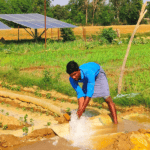The Advantages of Boots on the Ground: Is it Really Possible to Digitize the Last Mile in Smallholder Agriculture?
The Fourth Industrial Revolution is arguably already underway. It has been described by the World Economic Forum as distinct from the digitally-based Third Industrial Revolution in its “velocity, scope and systems impact”– something that could fundamentally change the way we interact with one another and our surroundings. The Fourth Industrial Revolution is creating a world where billions of people are connected to one another through mobile devices, and is increasingly focusing on what technologies like artificial intelligence can do with the immense sets of data these connections produce on a daily basis. It promises to alter humanity in unimaginable ways, bringing even greater change than the first (mechanized production), second (mass production) and third (digitally-enabled automated production) industrial revolutions.
These innovations already infiltrate everyday life in some parts of the world. But discussions of the potential extent of this transformation don’t always mention that much of the planet’s population still lacks access to the prerequisites of the previous three revolutions, including electricity, machinery and digital equipment and infrastructure.
The Revolution Has Yet to Reach Smallholders
This is exemplified in the smallholder farm. In industrialized agricultural contexts, actors involved in food production are taking significant advantage of imaging, sensing and Internet of Things (IoT) technologies at every stage across value chains. Yet in the supply chains that feed much of the world, these technologies are just beginning to be deployed – and this is happening through limited product offerings in markets where access to internet connectivity and basic mobile phones is still uneven. These contrasting dynamics create a complex business environment that requires enterprises to creatively leverage physical (i.e. transport and people) and digital (i.e. satellites and mobile phones) tools to enable quality service delivery models for smallholders.
Financial service providers and fintechs are often at the forefront of these efforts, facing the challenges of delivering credit, savings, insurance and payment products to smallholders via digital channels that aim to disrupt traditional brick and mortar services. These efforts often involve two different approaches: One establishes digital business-to-customer (B2C) relationships with farmers directly through more remote means of contact (i.e. satellites, call centers, etc.) The other leverages existing physical human networks, such as value chains, to deliver business-to-business (B2B) services that can improve smallholder livelihoods. The sections below highlight some key components of each.
Remote Sensing and Digitally Based Relationships with Farmers (B2C)
The B2C approach relies heavily on using the mobile channel to communicate with farmers directly, usually deploying call centers to support customer acquisition and management. Companies that offer index insurance or input credit products to smallholders also deploy remote sensing technologies, such as satellite imagery, weather stations and even drones to collect data. Some key highlights to consider with this particular business model include:
- The focus on direct client relationships enables providers to be less dependent on agricultural value chain actors as intermediaries. This means they can provide their services to smallholders who are not connected to more organized value chains, which expands their addressable market significantly, as only 7 percent of smallholders worldwide participate in highly organized value chains like coffee and cocoa.
- Establishing a direct relationship with the client enables these companies to have greater control over training data, which are the early datasets essential to helping machine learning programs better process information. As more data is fed into these programs, their ability to predict creditworthiness or trigger insurance payouts will also improve.
- However, training data and other early-stage datasets that exist for B2C models still require physical verification, which necessitates field staff. An example of this would be confirming where a smallholder’s plot is located instead of simply relying on a location captured remotely. As these services gather more data, the goal is to reduce the need for these field operations, but they will be necessary for the foreseeable future.
Digitizing Value Chains and Human Networks (B2B)
The B2B approach involves companies that seek to serve smallholders via value chain partners that provide inputs or purchase outputs. These companies believe that their partners’ human networks can be better organized through the use of digital channels. This service delivery model assumes these value chain partners already possess a large amount of information about smallholder farmers that is locked away in paper ledgers – or simply in the minds of members of those human networks. Providers could use digital tools to better organize and analyze this information, and use it to deliver more relevant data that informs a variety of financial products, such as credit, savings and payments. Some key highlights to consider about the human networks approach include:
- The B2B approach means engaging small and medium enterprises that probably have better access to smartphones, tablets and internet connectivity than the smallholders with whom they work closely. This allows for more sophisticated and feature-rich product development.
- While working with value chain partners means they don’t need to deploy their own boots on the ground, many providers have found customer acquisition suffers when they depend on someone not directly linked to their products to make sales. This has required them to establish their own local agent representatives in many cases, to support their partners’ existing human network channels.
- Working with value chain partners enables companies to tap into deep knowledge and understanding of a specific market segment. Yet being linked to specific value chain partners may also limit their ability to serve a broader segment of smallholders.
Evolving Service Delivery Models
At this point in their evolution, these two types of service delivery models have one primary characteristic in common: the need for an on-the-ground presence for product success. We will see if this changes as they continue to iterate on their approaches.
If you are interested in learning about new service delivery models that are leveraging both the physical and the digital to serve smallholder farmers, please consider taking an online course developed by myself and colleagues at DFI, which will be offered starting November 5, 2018. This course, Digitizing the Last Mile in Smallholder Agriculture, is designed to help students understand a broader framework for applying digital channels to the smallholder context, and apply some of these learnings in their own product design and delivery.
Hamilton McNutt is Vice President at Strategic Impact Advisors, a global consulting firm focusing on digital finance.
Photos courtesy of the author.
- Categories
- Agriculture, Technology



